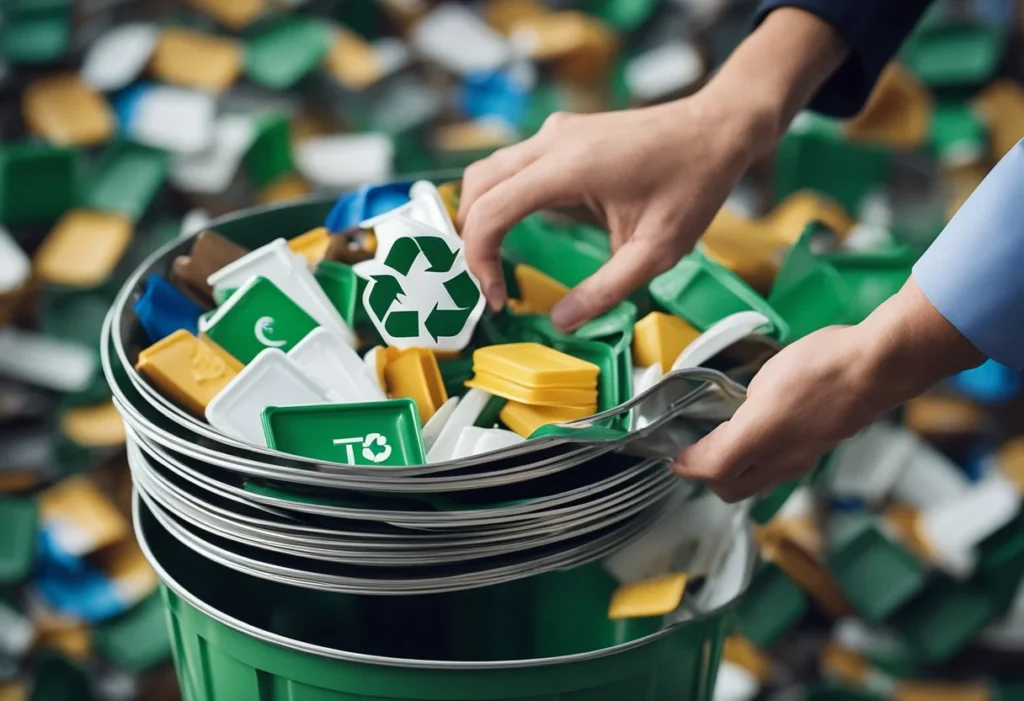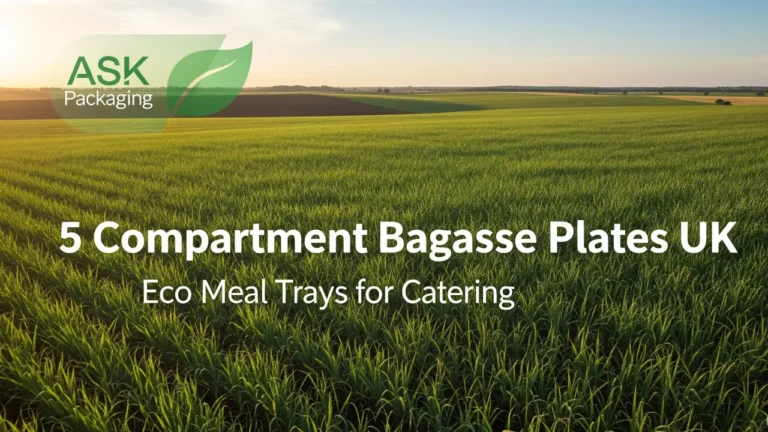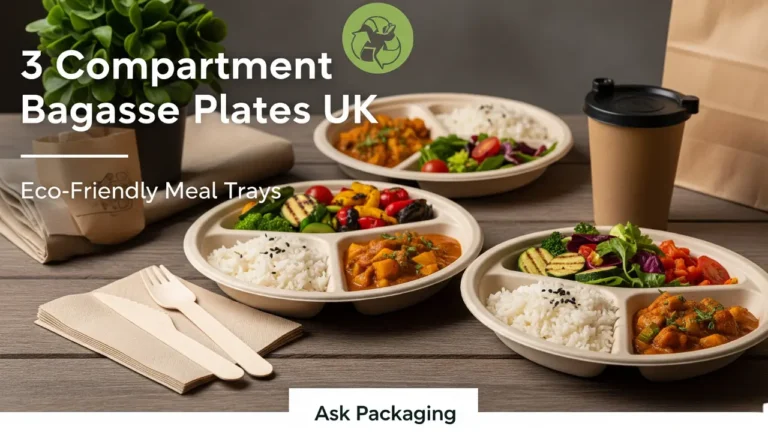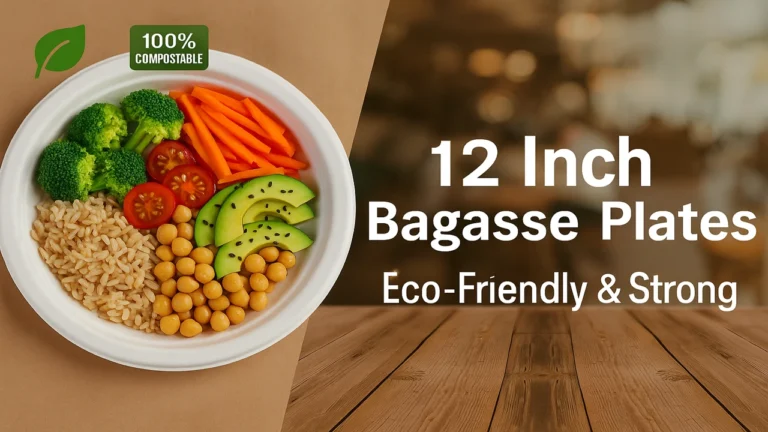Disposable plates are a convenient solution for serving food at parties, picnics, and events when washing up is not an option. They are available in many materials, including sturdy paper, plastic, and eco-friendly options like bagasse, making it easy for us to choose plates that suit hot food and everyday use.
Many of these plates are also available in bulk, making them useful for large gatherings or for businesses in the food service industry. With more of us looking for sustainable choices, eco-friendly options such as bagasse disposable plates made from sugarcane fibre are becoming more popular because they are compostable and biodegradable.
For those who need strong disposable plates that can go in the microwave and handle hot food, 10-inch bagasse plates or other sizes are a reliable choice. When considering starting a disposable plates business, it’s important to find a well-known supplier such as Ask Packaging Ltd for trusted quality and supply.
- Disposable plates come in various materials and strengths.
- Eco-friendly plates like bagasse are better for the environment.
- Buying from a trusted supplier supports your needs and sustainability.
What Are Disposable Plates?
Disposable plates are made to be used once and then thrown away. They are valued for their convenience, variety of materials, and ability to keep clean up quick and simple at gatherings, events, and takeaways.
Definition and Key Features
Disposable plates are single-use dishes designed to hold food and be discarded after use. They help save time and effort, as there is no need to wash up.
These plates are available in many sizes, including smaller options suitable for desserts or appetisers and larger plates for full meals. We can find plates made from different materials such as paper, plastic, and plant-based fibres.
Most disposable plates are lightweight, stackable, and easy to transport. Many options, like 9-inch paper plates, are strong enough to handle hot or cold foods without bending or leaking.
Types of Disposable Plates
There are several main types of disposable plates, each with its strengths.
1. Paper Plates are popular for picnics, parties, and events because they are lightweight, compostable, and often made from recycled or renewable materials.
2. Plastic disposable plates are favoured where extra sturdiness or resistance to wet foods is needed. However, they are less eco-friendly because plastic is slow to break down in the environment.
3. Bagasse Plates – We also see options made from natural materials like bagasse (sugarcane fibre), bamboo, or palm leaves.
These biodegradable plates are a sustainable choice and break down faster than plastic. We can find eco-friendly plates in different styles and sizes, including smaller 6-inch plates for snacks or desserts.
Materials Used in Disposable Plates
We use different materials to make disposable plates, each offering specific features such as cost, strength, and environmental impact. Some are lightweight and cheap, while others are made to decompose quickly or come from renewable resources.
Paper and Cardboard Plates
Paper plates are commonly made from paperboard or pulped wood. We often see these plates covered with a thin coating to make them resistant to leaks and grease. This coating is usually a type of plastic or wax.
Cardboard plates are similar, but they use thicker layers pressed together for added strength. Both types offer a simple solution for serving food at parties or events. However, unless labelled as compostable, most standard paper plates contain plastic coatings, making them less environmentally friendly.
Some plates use FibreForm paper, which is fully biodegradable and renewable.
- Usually from wood pulp or paperboard
- May contain plastic or wax coatings
- Lightweight and suitable for cold or dry foods
- May not break down easily if coated
Plastic Plates
Plastic disposable plates are usually made from polystyrene, polypropylene, or polyethylene. We choose these because they are durable, light, and cheap to produce in large numbers.
Polystyrene plates are rigid but can crack under pressure. Polypropylene and polyethylene plates are more flexible and less likely to snap. These plates are often used at big gatherings as they can handle heavier or oily foods without getting soggy.
However, plastic plates are not biodegradable. They can take hundreds of years to decompose in a landfill. Recycling options exist but are often limited depending on local facilities.
Common Types of Plastic:
| Material | Features | Uses |
|---|---|---|
| Polystyrene | Rigid, brittle | Parties, takeaways |
| Polypropylene | Flexible, heat-resistant | Catering, picnics |
| Polyethylene | Lightweight, soft | Light meals, snacks |
Compostable and Biodegradable Options
Bagasse plates are made from the leftover fibres of sugarcane after juice extraction. We select these because they use agricultural waste and are both compostable and biodegradable. Other eco-friendly disposable plates might be made from palm leaves, bamboo, or specially designed bioplastics.
These plates can handle hot, wet, and oily foods well. Once used, bagasse and other plant-fibre plates break down in industrial composting facilities. They are ideal for reducing waste and are widely accepted at green events.
Some compostable options require special composting conditions. It’s important to check the labels to be sure plates will break down as promised.
Examples of Compostable Materials:
- Bagasse (sugarcane fibre)
- Bamboo
- Palm leaves
- PLA (plant-based bioplastic)
Popular Uses for Disposable Plates
Disposable plates make serving food quick and easy. They are widely used by hosts, caterers, and families because they save time, limit washing up, and offer a hygienic option in many settings.
Parties and Special Occasions
We see disposable plates at many parties and events, such as birthday gatherings, picnics, and weddings. At these occasions, large groups of people eat at once, so we need a practical solution for serving food.
Disposable plates help us manage everything from sandwiches and finger foods to cakes and cookies. Using them also means we do not have to worry about broken plates or washing dishes after the event.
For big weddings and special banquets, selecting high-quality disposable plates, sometimes with decorative designs, adds to the look of the celebration. This convenience is especially helpful when organisers serve many guests in outdoor or rented venues.
Food Service and Catering
In the catering industry, disposable plates are essential. Many catering companies rely on them, especially when delivering food to corporate meetings, school fetes, or community events.
Caterers often serve items like salads, snacks, and desserts, including cookies and pastries, on these plates. Disposable options allow for fast set-up and clean-up. This is important at busy events where staff must focus on serving customers rather than washing up.
For food trucks and pop-up cafés, disposable plates mean we can serve hot meals quickly. Some are designed to handle heat, making them suitable for dishes straight from the oven or microwave.
Everyday Convenience
Many households use disposable plates for daily meals, especially when quick clean-up is needed. They are useful for packed lunches, family picnics, and snacks at home.
On busy days, using disposable plates helps us save time that would otherwise be spent on washing up. Parents often choose them for children’s parties so the kids can enjoy cake and cookies without the risk of broken crockery.
Disposable plates also offer a hygienic solution when sharing food with friends or bringing meals to others, such as during illness or community support events. This makes them a practical choice for both planned occasions and unexpected needs.
Environmental Impact and Sustainability
Disposable plates have a substantial effect on our environment due to the materials used and their end-of-life treatment. Choosing plates that are eco-friendly or recyclable can help us lower negative impacts.
Environmental Conditions Affecting Disposal
How we discard disposable plates hinges on environmental conditions such as temperature, humidity, and access to composting or landfill sites. For example:
- Plastic plates: These are not biodegradable. In landfill sites, they may take hundreds of years to break down. Sun and heat do little to speed up their decomposition.
- Paper plates: While they seem compostable, coatings or dyes can prevent breakdown, especially in landfills with low airflow.
- Compostable plates: These require industrial composting conditions—high heat and controlled moisture – to fully decompose. In home compost bins or open landfill, they may persist much longer.
If disposed of in unsuitable conditions, even “eco-friendly” plates might not decompose as intended. Limited access to proper facilities can lead to increased pollution and litter.
Recycling and Waste Management
The recyclability of disposable plates depends on their material and if they are contaminated by food. Here’s a comparison:
| Type | Material | Recyclable? | End of Life |
|---|---|---|---|
| Plastic | Polystyrene | Rarely | Landfill |
| Paper | Paperboard | Sometimes | Compost |
| Compostable | Bagasse, bamboo | Compostable, not recyclable | Compost |
Contaminated plates, especially those with food waste, are almost never recycled. We need strong waste management systems to separate and treat these items. When effective, recycling and composting reduce landfill use and cut plastic pollution, but availability varies greatly by region. Eco-friendly choices only work when paired with proper collection and processing.
Legal and Ethical Considerations
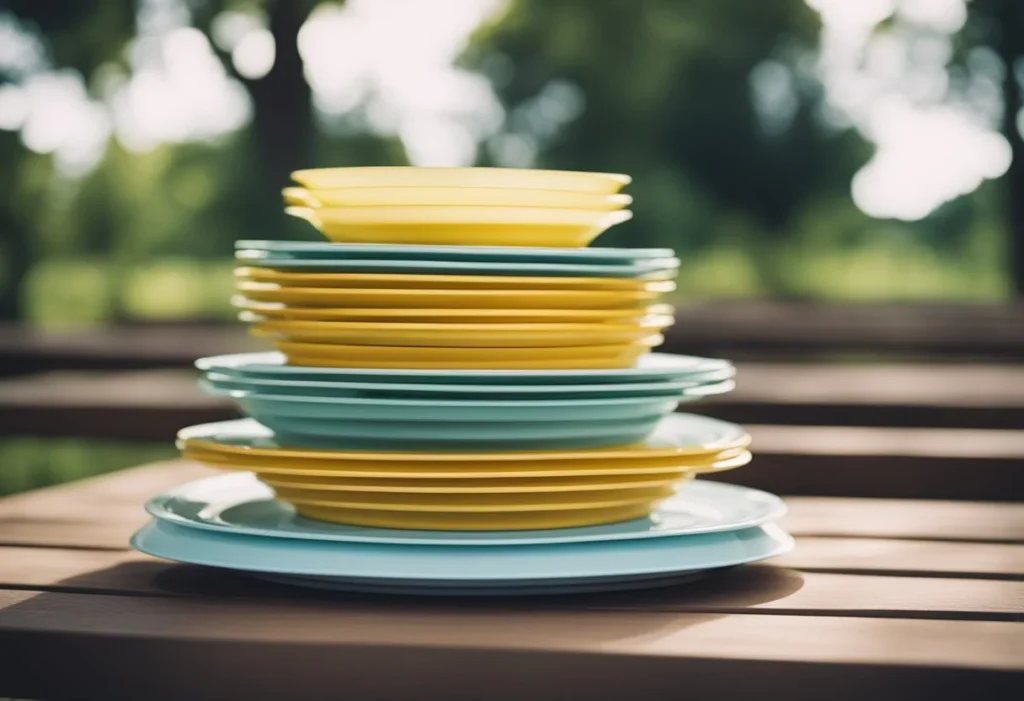
When using or selling disposable plates, we have to think about both following the law and acting responsibly. The main concerns are keeping people safe and making sure personal information is handled with care.
Health and Safety Regulations
We must ensure that all disposable plates meet strict food safety rules. In the UK, products that come into contact with food need to follow the Food Contact Materials Regulation. This means our plates must not release harmful chemicals into food, even when used with hot or acidic dishes.
Labelling is important. Plates should have the correct safety marks, such as CE markings, if required. We should also provide clear instructions for safe usage, especially for plates made from new materials like bioplastics or compostable fibres.
If we import or sell disposable plates, we need to keep records in case there is a recall or problem. This includes supplier information, material safety data sheets, and test results. Authorities can ask for this information during inspections or if there are reports of people getting sick.
Privacy Policy and Data Handling
When selling disposable plates online or collecting customer information for deliveries, we are responsible for protecting personal data. The UK General Data Protection Regulation (GDPR) requires us to explain how we collect, use, and store data in a clear privacy policy.
We should only collect the data needed to process orders, such as name, address, and payment details. Customers must give consent for their data to be used. If we share information with couriers or other companies, we must make sure they follow proper data protection rules.
Our privacy policy needs to be easy to find and written in simple language. This helps build trust and ensures we meet legal obligations. Regular reviews help keep our data practices up to date and safe for everyone involved.
Choosing the Right Disposable Plates
When choosing disposable plates, we must look at the size, material, and intended use. Customer support can also make a big difference if we have special needs or bulk orders.
Factors to Consider
The main things we need to think about are plate size, material, and how the plates will be used. Common sizes include dessert plates (6-7 inches), luncheon plates (8-9 inches), and dinner plates (10-12 inches). Here’s a quick look:
| Plate Size | Best For |
|---|---|
| 6-7 inch | Cakes, snacks, small desserts |
| 8-9 inch | Sandwiches, salads, lunch |
| 10-12 inch | Main meals, larger portions |
When it comes to materials, we often choose from plastic, paper, foam, or compostable options. Plastic plates are sturdy and good for heavier foods. Paper is lighter and usually more eco-friendly. Compostable plates break down quickly and suit green events. We should also check if the plates are microwave-safe or suitable for hot or wet foods.
Help and Customer Support
Customer support can guide us through bulk orders, returns, or choosing the right product for specific events. Many suppliers offer a help line or live chat. We can look out for sites with clear contact details for quick answers. Some companies provide advice on custom orders, branding, or recycling information.
If we’re unsure about quantities or materials, friendly support makes the process smoother. Good help can make it easier to match our needs with the correct size and style, and even explain disposal or eco-friendly choices. It’s always best to check reviews or service ratings before buying in large amounts.
Frequently Asked Questions
Choosing disposable plates means considering the materials, cost, environmental impact, and practicality. Different events and needs may require specific types of plates, and buying options are widely available.
What materials are considered best for disposable plates intended for hot food?
You find that palm leaf, sugarcane (bagasse), bamboo, and heavy-duty paper plates all work well for serving hot food. These materials usually hold up without bending, leaking, or becoming soggy. Plastic plates designed for heat are an option, but they are less popular due to environmental concerns and recent bans.
Are there eco-friendly alternatives to plastic disposable plates?
Yes, we have several options. Palm leaf, bamboo, sugarcane, and cornstarch-based plates are popular biodegradable choices. These materials break down more quickly than plastics and are made from renewable resources. Some can also be composted at home or through industrial composting services.
How can I purchase disposable plates in bulk?
You can buy disposable plates in bulk Ask Packaging Official Store or from Amazon. Many supermarkets also offer bulk packages. Ordering directly from manufacturers is another option, especially for larger events.
What factors should be considered when choosing disposable plates for a party?
You should think about the type of food served, the formality of the event, and the environmental impact. It’s also important to check if the plates can handle hot, cold, or oily foods. Ease of disposal and cost per plate are factors as well.
Where can I find biodegradable disposable plates at a local retailer?
You can find biodegradable plates on Ask Packaging store. Visit this store online and buy the products online. They are offering free next day delivery all over the United Kingdom.
What is the comparative cost efficiency of using disposable plates versus traditional crockery?
Using disposable plates can save your time on washing up, especially for big events. However, over many uses, traditional crockery is usually cheaper. The cost difference depends on the size of the gathering, frequency of use, and local waste disposal fees.

